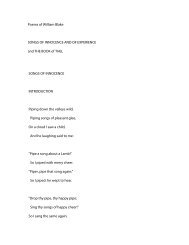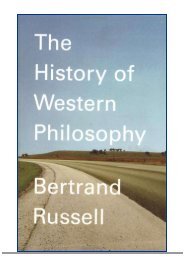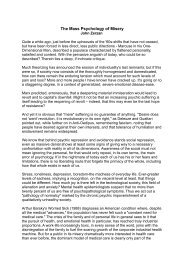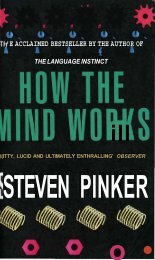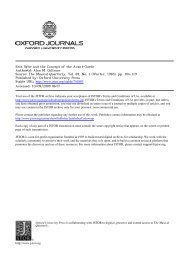The Ever-Present Origin - Michael Goodnight - Editor
The Ever-Present Origin - Michael Goodnight - Editor
The Ever-Present Origin - Michael Goodnight - Editor
- No tags were found...
You also want an ePaper? Increase the reach of your titles
YUMPU automatically turns print PDFs into web optimized ePapers that Google loves.
of the last few centuries to an extreme dualistic form of thinking whichrecognized only two antithetical and irreconcilable constituents of theworld: measurable, demonstrable things, the rational components ofscience which were valid; and the non-measurable phenomena, theirrational non-components, which were invalid.To the perspectival age time meant nothing but a system ofmeasurements or relationships between two moments. Time as a qualityor an intensity was simply not taken into account and was deemed to beonly an accidental and inessential phenomenon. Time, however, is a muchmore complex phenomenon than the mere instrumentality or accidence ofchronological time. <strong>The</strong> fact that we today still think in terms of thespatial, fixed, three-dimensional world of conceptuality is an obstacle toour realization of the more complex significance of the phenomenon.Anyone who dares to venture such a realization is accused ofterminological obfuscation. But this should not prevent us from statingthat time as a reality encompasses still other essential forms ofappearance which are proper to it alone and not to space.To the perception of the aperspectival world time appears to be the veryfundamental function, and to be of a most complex nature. It manifestsitself in accordance with a given consciousness structure and theappropriate possibility of manifestation in its various aspects as clocktime, natural time, cosmic or sidereal time; as biological duration, rhythm,meter; as mutation, discontinuity; relativity; as vital dynamics, psychicenergy (and thus in a certain sense in the form we call "soul" and the"unconscious"), and as mental dividing. It manifests itself as the unity ofpast, present, and future; as the creative principle, the power ofimagination, as work, and even as "motoricity." And along with the vital,psychic, biological, cosmic, rational, creative, sociological, and technicalaspects of time, we must include—last but not least—physical-geometricaltime which is designated as the "fourth dimension."This seemingly random enumeration of temporal aspects may bedisconcerting to someone unable to disengage himself from his threedimensionalconception of the world. To a systematician these aspects willseem to be incongruent quantities. But they are not quantities: they areelements and functionals which cannot be conceived of or arrayed inspatial terms. <strong>The</strong> apparent lack of a system that seems to prevail in ourenumeration in fact corresponds to the respective realities.What is effected can be understood systematically; but the power to effectcannot, unless we wish to perpetuate the mistakes of perspectival man byerroneously converting intensities into spatial extensities. We should alsoavoid the error of placing the "effected" into a causal relationship with the"effecting." And we should avoid the additional error of considering themin a dualistic fashion as antitheses, since this would amount to yet afurther systematization.Nor can a purely categorical mode of consideration do justice to the65



